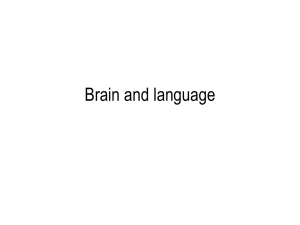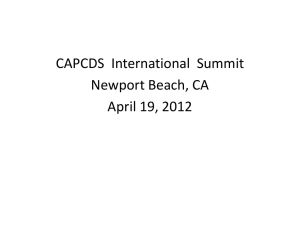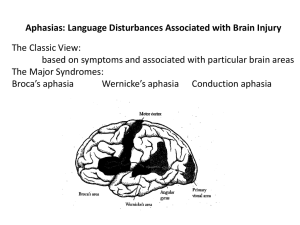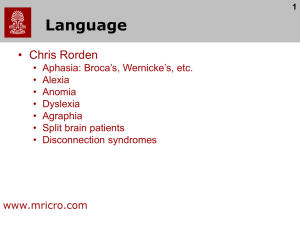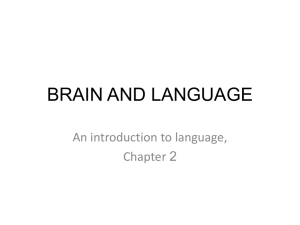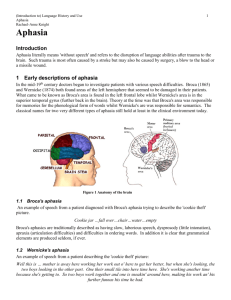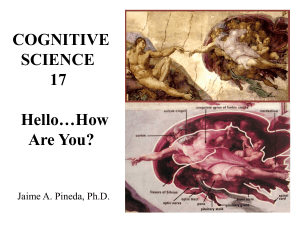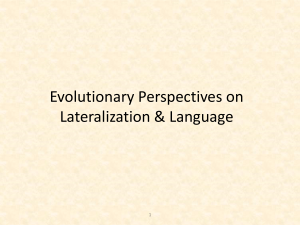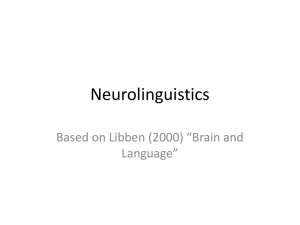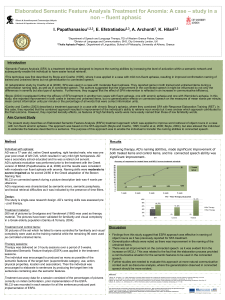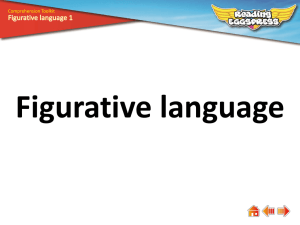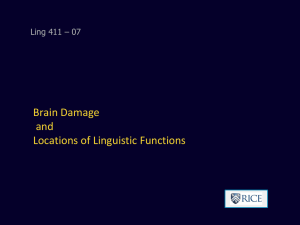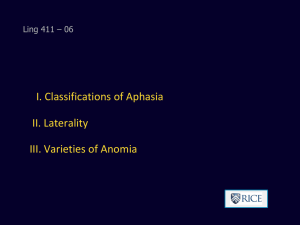Speech and Language
advertisement
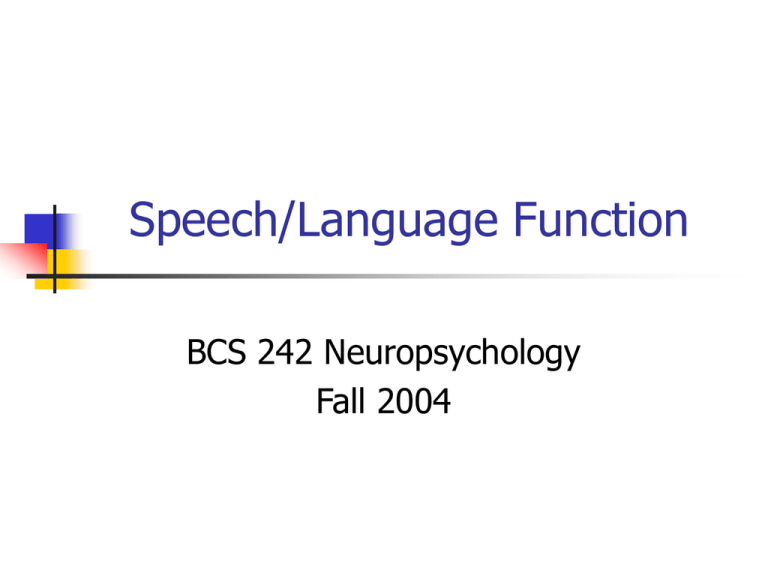
Speech/Language Function BCS 242 Neuropsychology Fall 2004 Brief Anatomy In >96% of right-handers and 70% of lefthanders, left hemisphere is “dominant” for speech and language Different areas implicated in different functions For example, anterior location for speech production (left frontal lobe); posterior for speech comprehension (left temporal-parietal region) Roles played by subcortical structures (basal ganglia, posterior thalamus) and right hemisphere less well understood Brain areas involved in Language Basic Language Components Auditory Comprehension Visual Comprehension Articulation Word Finding Grammar/Syntax Repetition Verbal Fluency Writing Prosody Language Deficits Aphasia – spoken language Alexia – reading Agraphia - writing Anomia - naming Dysarthria - articulation Types of Language Errors Paraphasia: Neologism: Talking with considerable effort Agraphia: Paraphasia with a completely novel word Nonfluent speech: Substitution of a word by a sound, an incorrect word, or an unintended word Impairment in writing Alexia: Disturbances in reading 19th Century Neuropsychology Broca (1865) described patients who displayed halting, agrammatic speech Content words were well preserved Function words (i.e., adjectives, articles) impaired Broca’s Aphasia Patient “Tan” Brain tumor in Left frontal brain region Broca: Lesion disrupted speech Broca’s Aphasia “Yes… ah… Monday… er… Dad and Peter H… (patient’s name), and Dad… er… hospital… and ah… Wednesday… Wednesday, nine o’clock… and oh… Thursday… ten o’clock, ah doctors… two… an’ doctors… and er… teeth…yah Goodglass & Geschwind, 1976 Broca’s Aphasia Broca’s Aphasia – Damage to “motor images” Language comprehension skills relatively preserved Typically observed in patients with damage to left inferior prefrontal cortex Wernicke’s Aphasia Neologisms Speech appears to have no information content “fluent nonsense” Preserved function words, impaired content words Comprehension impaired Even simple sentences not well understood Associated with left temporal lobe damage Wernicke’s Aphasia “Well this is… mother is away here working her work out o’here to get her better, but when she’s looking in the other part. One their small tile into her time here. She’s working another time…” Goodglass & Geschwind, 1976 Broca’s, Wernicke’s Area, and Connections Lichtheim’s (1885) and Geschwind’s (1965) model Auditory input mediated by Wernicke’s area Motor output mediated byBroca’s area Regions connected by arcuate fasciculus Aphasia Syndromes I Fluent (receptive) Aphasias: All have FLUENT speech and no articulatory disorder; problems with comprehension and/or repetition Wernicke (aka sensory): neologisms/anomia/ paraphasias, poor comprehension and repetition Transcortical Sensory(aka isolation syndrome): intact repetition; paraphasias/anomia, poor comprehension Conduction: phonemic paraphasias/neologisms, poor repetition, fairly good comprehension Anomic (aka amnesic):anomia and some paraphasias; all else intact Aphasia Syndromes II Nonfluent (expressive) Aphasias: All have articulatory disorder but relatively preserved comprehension Broca (aka motor, expressive, nonfluent): speechlessness with recurring utterances or phonetic disintegration, or phonemic paraphasias with anomia, agrammatism, and dysprosody; poor repetition Transcortical Motor: uncompleted sentences and anomia; naming better than spontaneous speech; repetition fairly intact Global: speechlessness with recurring utterances, poor comprehension, poor repetition Aphasia Syndromes III “Pure” Aphasias – selective impairments with NORMAL speech production Alexia without Agraphia: poor reading Agraphia: poor writing Word Deafness: poor comprehension, poor repetition Major Aphasia Syndromes Type Production Comp. Repetition Naming Global impaired impaired impaired impaired Broca’s not fluent intact limited limited Wernicke’s fluent/ impaired impaired impaired impaired Anomic fluent/ intact circumlocutory intact impaired Mixed/ nonfluent impaired limited limited Conduction fluent/ intact circumlocutory impaired limited limited Right Hemisphere Contribution to Language Functions Good comprehension for gestural language Prosody (inflection, timbre, melody) Semantic language (word recognition, verbal meaning, concepts, and especially visual meaning) Assessment of Language Standard Aphasia Batteries (e.g., Western Aphasia Battery, Boston Diagnostic Aphasia Exam, Halstead Aphasia Screening Test) Boston Naming Test Token Test Verbal Fluency Written Expression (e.g., Cookie Theft)
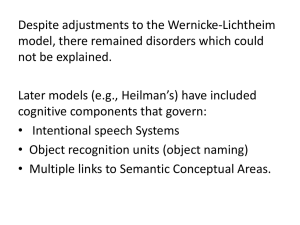
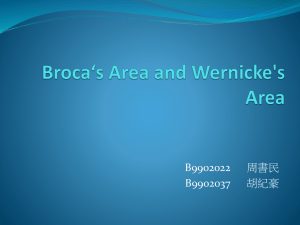
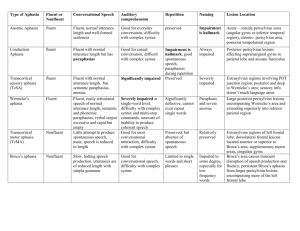
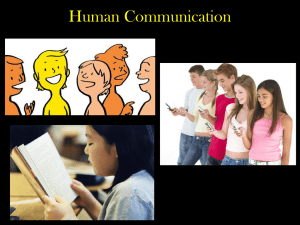

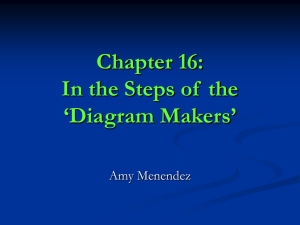
![Wernicke`s_area_presentation[1] (Cipryana Mack)](http://s2.studylib.net/store/data/005312943_1-7f44a63b1f3c5107424c89eb65857143-300x300.png)
